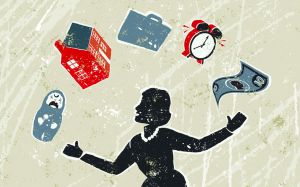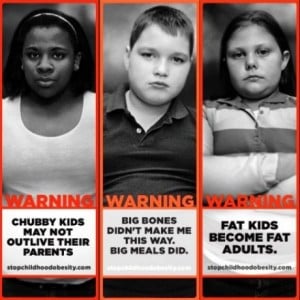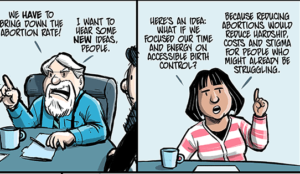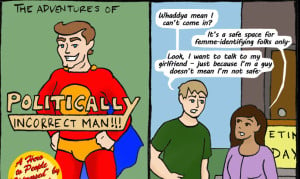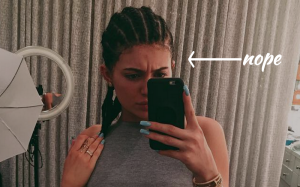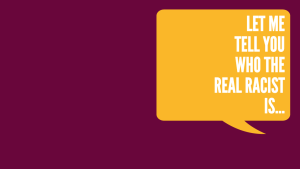I became a single mom in the fall of 2012 when my partner died suddenly. But while the experience was devastating on many levels, it was not something that left me impoverished.
And that is a big deal in a country where almost 4.1 million single moms live under the poverty line.
So what about my situation helped me keep my head above water?
The two main things were that I had completed my education, and as a result of that, I already had a solid teaching job. Combined with an incredibly supportive family and community, this meant that I found myself more financially stable than the majority of single moms.
Partly, that is because a lot of folks and their families are systematically blocked from having access to the same resources that I did as a white middle class mom with a backstory that elicited a lot more sympathy than blaming.
But everyone deserves to have access to the same resources for survival and lacking my privilege sure shouldn’t mean that poverty will be your default if you are raising kids alone.
Sadly, this is far too common.
There are a few reasons for this. One is the systemic advantages that some people experience.
Another is that in the United States, the combination of the enduring anyone can make it myth and the “you should just pull yourself up by your bootstraps” mentality results in an acceptance of the idea that a family headed by a single mom will likely (and sometimes even deservedly) be a poor one.
Though we don’t typically acknowledge this, the result is that we just assume that it’s normal for single moms to experience systemic exclusion. But since we aren’t socialized to think of it as our responsibility to change things, this exclusion tends to continue unchallenged.
Plus, there remains a pretty harsh condemnation of people whose families do not resemble some fictional ideal. This view allows us to blame single mothers for their poverty, which leads to the acceptance and even the expectation of that poverty.
But contrary to what we have been told, one’s financial position isn’t simply a situation of one’s own making. Rather, it is the product of living in a country where the path out of poverty, especially for single moms, can be next to impossible.
Here are four reasons why this is – and a few ideas for challenging the status quo.
1. Poverty Wages Are Common Among Single Moms
If you are a single mom, it will come as no surprise to you that more than half of low-income single mothers work full-time. However, they often work in poorly paid jobs without benefits.
According to the National Women’s Law Center, of the 7.3 million families headed by working single mothers, over 2 million live well below the national poverty line – and almost an additional 2.5 million working single mother families are struggling to make ends meet.
In large part, that’s because women are more likely to be working at minimum wage jobs without benefits than are men.
As Laura D’Andrea Tyson, a business professor at the University of California – Berkeley, writes in the New York Times, “The typical worker earning the minimum wage is not a teenager and is not male. She is an adult woman…Many, of course, are working and taking care of children.”
What We Can Do
When people oppose raising the minimum wage (which has basically has been stagnant for decades), they are in effect keeping millions of single moms, and their kids, impoverished, since a person working full-time at the current minimum wage earns less than $14,500 annually.
That’s over $4,000 below the poverty line for a parent with two kids. And it’s a hell of a lot less than anyone in this country needs to live on.
Rather than worry about how businesses will survive (trust me – most will be just fine), support the campaign to raise the minimum wage.
For example, get involved with the powerful movement across the country to raise the wages of fast food workers. You can find more about that at Fight for $15.
2. Most Single Moms Lack Paid Leave
The US is one of the few countries in the world that doesn’t guarantee that all mothers can take paid time off when they give birth or adopt.
So what is guaranteed? It really depends on where you work and where you live.
Though some states have better programs, the only federal protections come under 1993’s Family and Medical Leave Act, which allows new moms twelve weeks of unpaid leave. But all this means is that you can’t get fired for twelve weeks after having or adopting a child.
However, in order to even get this limited security, you need to have worked full-time for at least a year in a company with a minimum of fifty employees.
But while this might shock people across the globe, many Americans – myself included – just take this for granted.
For example, I returned to work soon after the birth of each of my three children. I was back at seven weeks with my oldest daughter, at four months with my son, and recently, at three months with my new baby.
I know that I’ve felt guilty for complaining since I’m a teacher on the school calendar. So I find myself saying things like, “Well, I can’t really whine about going back so early. I do get summers off after all.” But really those two things have nothing to do with each other!
Still, while denying parents time off penalizes everyone, for single moms, who have to shoulder all their family’s financial needs alone, often with incredibly limited means, a lack of paid leave can be disastrous.
Plus, it isn’t only a lack of maternity leave that can hurt single moms.
The US is also one the few countries that doesn’t guarantee that workers can take time off if they or their loved ones are sick. This can obviously be devastating if you have a medical issue, and it can also be a real problem if you need to be a caretaker, something that the Family Caregiver Alliance reports is far more likely to be done by women than men.
What We Can Do
Having a child or a sick relative simply shouldn’t cost you your job. But in many cases, that’s just what happens.
And when you are the sole provider for your kids, the slide into poverty is often a direct effect of our lack of job protection for pretty common occurrences.
Though not all companies will be receptive, approaching your company’s HR department (or asking a supervisor to) can actually affect change.
You might want to arm yourself with some sample policies, like this one and this one. Plus, this article from Susan Wojcicki, the CEO of YouTube, who was the first employee to get maternity leave at Google, explains how maternity leave is actually good for business.
3. Affordable Childcare Is Often Far Out of Reach
Along those lines, it’s not like we say, “Look, parents need to come back to work right away, but here is this great affordable childcare option to help them do so.”
In reality, figuring out and paying for childcare is left up to individuals. And as any parent knows, the cost of childcare can be astronomical. In fact, it is often more than what families spend on rent and food combined!
As my single mom friend, Jen, told me, though she had been working full time, after her son was born, she realized she simply couldn’t afford childcare. So she stayed home and lived off credit cards for a year, something she is still trying to dig her way out of years later.
And while there are some government programs to help with childcare costs, these are both hard to come by, and in recent years, have been on the decline.
I’ve felt super lucky to have found affordable childcare at various points in my kids lives. But I also know how much I have had to shell out to babysitters and for daycare when this wasn’t possible.
Plus, though the Obama administration has introduced a bill aiming to increase the Child and Dependent Care Tax Credit from $1000 to $3000 per child to help cover childcare costs, even if this passed, the fact is, it would just be a drop in the bucket.
Indeed, weekly child care expenses rose more than 70% between 1985 and 2011, and today it costs $16,500 a year on average for care for just one child – and more if you are looking for infant care.
While some countries, like France and Australia, offer government subsidized childcare, in America, we are just left to our own (expensive) devices.
What We Can Do
I wish there was an easy and affordable childcare solution, but until then you can consider enlisting teen sitters for after school hours, doing babysitting trades with friends and neighbors, setting up a babysitting co-op, using in-home daycares (which are often licensed, but as they only take five or six kids and don’t have a web presence, finding them involves a lot of word of mouth), reaching out to family, rigging your work schedule, and asking people beyond your inner circle what they do for child care.
You can also join local single parent support groups (hopefully those have childcare provided!) and single parent listservs to find out about options in your area.
4. Barriers to Education Abound
Many studies have demonstrated that education is an increasingly crucial path out of poverty. However, not all forms of education are created equal. What is really worthwhile is a four-year degree from an accredited university.
Yet, as Amanda Freeman points out in an article in the Atlantic, we make it incredibly hard for single moms to get these types of post-secondary degrees.
She explains that the Welfare Reform Act of 1996 (nicknamed “welfare-to-work”), was supposed to replace cash assistance with job and educational training. And while this sounded good to a lot of people, the act limited the definition of “work” to nine categories and then only provided assistance for certain programs, mostly vocation-focused training, and only for a maximum of one year.
As she writes, “For single parents who rely on public assistance, college classes do not count as ‘work’ in most states, so many of those who return to school lose access to benefits like child care vouchers and cash assistance.”
To add insult to injury, a lot of these programs don’t produce the kind of training or credentials needed to actually get a well-paying job.
As the journalist Adam Davidman writes, many private for-profit institutions “seem to be little more than a scam, recruiting students, taking their government-funded loans and offering them a degree of minimal worth.”
That exact thing happened to my friend Sabrina. A single mom to a toddler with a few years of college, but no degree, Sabrina learned that while she could get some state funds to attend an ultrasound technician program, she could not get assistance to go back to a four year college.
So she attended the ultrasound program and got “certified” only to discover that the certification itself was not actually accepted by any employer. And since the assistance was only partial, she ended up with debt and a useless piece of paper.
Luckily, she was able to move back in with her mom who could watch her daughter while she worked a retail job. So, I guess if there is an upside, it’s that she didn’t find herself homeless. But living at home and making minimum wage sure wasn’t what she had anticipated after going back to school.
And while it might be tempting to blame Sabrina for not looking into the program more critically, when something has the stamp of government approval on it, it generally seems unnecessary to do so.
What We Can Do
Though the barriers to education can seem insurmountable, understanding what is available can make a huge difference. Sallie Mae offers information for single moms on getting funding for college here.
Alternatively, students who demonstrate high financial need are more likely to qualify for a federal grant. This federally-subsidized money does not need to be repaid, unlike a load. The most common type of grant for lower income students is known as the Pell Grant.
What will likely be your best bet however is a federal loans. These are issued by the federal government, and are usually a way better deal than are loans from banks and other private lenders since they offer lower fixed interest rates and have more flexible repayment options.
Plus if you apply as an independent single mother student you are usually eligible for higher loan limits.
Why the US Is Unique – And Not in a Good Way
The US has a long and ugly history of keeping certain groups impoverished – and single moms are no exception.
But the last thing single moms need is to be told that they are to blame for their financial hardships. In reality, the situation is just so much more complicated, and so much more structural, than something that can be reduced to any one person’s individual choices.
And that structure is unique to the United States.
A paper in the journal Demography analyzed the poverty of single mothers in relation to the total population both in the United States and abroad. It found that not only does the US have the highest poverty rate for single mothers among the 18 countries they reviewed, but additionally, while in the US, single mothers are 24% more likely to be poor than are other groups, this simply isn’t the case in the comparable countries.
The authors argue that universal anti-poverty programs, rather than those targeted directly at single mothers, are most effective.
But it’s unlikely we will see sweeping reforms here since anti-poverty measures aren’t popular among many Americans who often want to hold individuals – and not complex structural systems – accountable for our financial situations.
As a result of this view, what we get are piecemeal measures that receive limited funding, rather than sweeping reforms that might actually make a difference. Solutions are out there, but in order to put those into action we have to challenge the notion that poverty and single motherhood go hand-in-hand.
However, as long as we make higher education inaccessible, fail to provide a livable minimum wage or affordable childcare, and lack family-friendly workplace policies, poor single moms are going to have an awfully hard time becoming financially stable.
[do_widget id=’text-101′]
Ellen Kate is a Contributing Writer for Everyday Feminism. She’s a health educator, sometimes writer, and mom. She has worked at Manhattan’s Museum of Sex, developed sex education curricula in Mumbai, India, and run HIV prevention programs for at-risk teens in the South Bronx. Currently, Ellen runs a middle and high school health education program and teaches human sexuality at Brooklyn College. More of Ellen’s writing can be found here. Follow her on Twitter @ellenkatef.
Search our 3000+ articles!
Read our articles about:
Our online racial justice training
Used by hundreds of universities, non-profits, and businesses.
Click to learn more


